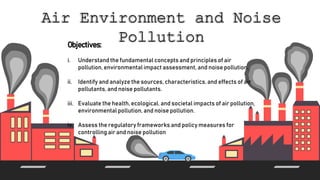The document discusses air pollution and noise pollution. It outlines 7 objectives related to understanding the concepts, sources, effects, and solutions for air pollution and noise pollution. The key topics covered include defining air pollution, identifying common sources such as fossil fuel combustion, vehicles, agriculture, and industry. Major air pollutants like particulate matter, ozone, nitrogen dioxide, and their health impacts are described. The effects of air pollution on humans, animals, plants and the environment are also summarized.













































